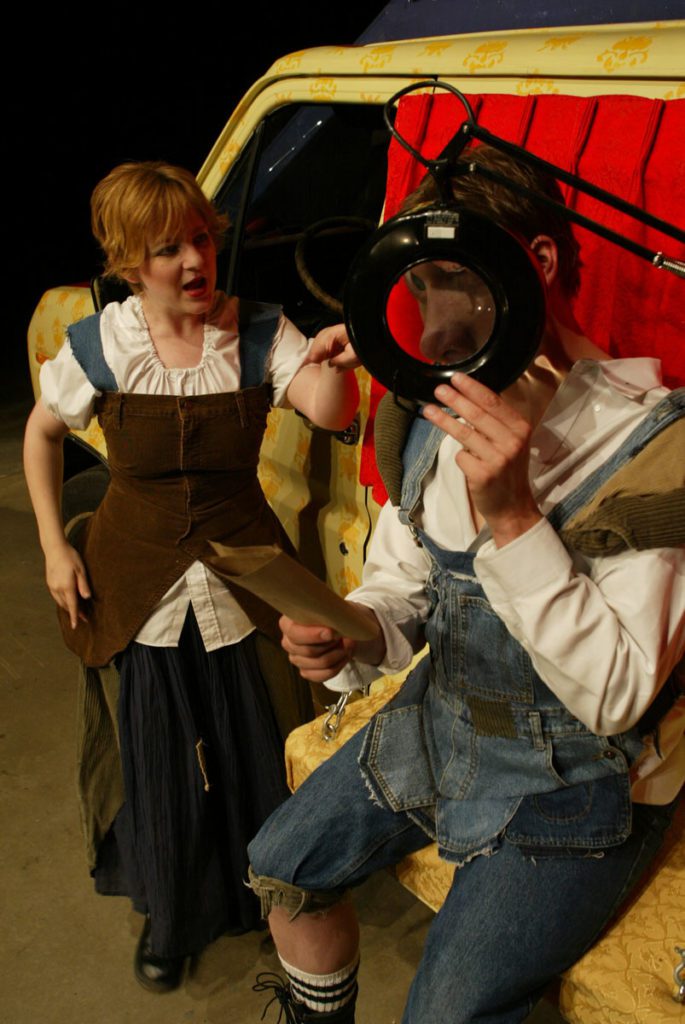If your aim is to poke fun at Will Shakespeare, why not start with Titus Andronicus? This early work masks young Will’s yet-to-ripen greenery as a playwright with buckets worth of stage blood, quenching the thirst for carnage that preceded his shift to an emphasis on character. And if a playful swipe at the Bard is on the bill, it helps to have the wit and resourcefulness of Buntport Theater, which in Titus Andronicus! The Musical stabs at the play’s thinly stretched canvass and runs the characters through with makeshift swords in the form of everything from trombones to dipsticks.
The award-winning, Denver-based theater company takes on the guise of a traveling band of thespians, prepared to perform any play wherever they pull up; P.S. McGoldstein carts his five member company and their wares in an old van. “We are few in number, but we are resourceful,” McGoldstein confides to the audience in a huge understatement as the play begins. The actors take on anywhere from three roles each to upwards of a dozen in the case of Evan Weismann, who plays the company musician as well as a parade of characters identified as “Someone Who Will Probably Die.” To help the audience up with the shifts between characters, the players operate a light board with a rendering of each actor and a series of bulbs below each rendering, one for each character they play. Next to this is a chalkboard on which to tally the ever mounting death toll. At times, the lights are flicked on and off as quick as the parries in a sword fight — most notably in a scene during which two of Erik Edborg’s characters, Saturninus and Lucius, engage in mortal combat.
The van is the play’s central set piece, epitomizing Buntport’s knack for turning seemingly insurmountable production challenges into jaw-dropping creativity. As the play-within-the-play commences, the van doors are opened to reveal a backdrop painted across the insides of the doors and a screen that rolls down, blocking the interior of the van and setting the scene with an image of ancient Rome’s famous Eiffel Tower — which, upon discovery, is quickly covered with another pull down screen depicting the more geographically correct Coliseum. The van is used to great comic effect throughout the show — e.g., the carriage rocks when Saturninus and Tamara consummate their marriage in the back of the vehicle. As for depiction of the play’s horribly tragic events, blood spurts out of the roof when a victim is hacked up inside, and the big picture window on the side of the van offers a view of the carnage that occurs after Aaron traps Titus’s sons in the forest.
Then there are the show’s musical moments; the company members perform several production numbers with macabre hilarity. I particularly enjoyed Edborg’s Frankensteinish dance moves as the rhythmically-challenged Saturninus in the opening number — a foreshadowing of the grand finale, when all of the corpses sing and twitch, whether marinating in a pool of their own blood or, in the case of Tamora’s two puppet sons, baked into pies for mother. There’s also a cha-cha version of “I Love You For Sentimental Reasons,” with the newly crowned Saturninus and the captured Goth queen Tamora dancing on the roof of the van before slipping inside for their honeymoon. And there’s a wonderfully romantic “montage” when Lavinia sneaks off to be with Bassianus (Saturninus’ brother). As The Carpenters’ “Close to You” plays on the van stereo, the two fall in love. But then the vengeful Tamora arranges for her sons — the car stereo and the gas can — to kill Bassianus and to maim Lavinia, cutting off her hands and tongue. This doesn’t keep Lavinia from singing an incomprehensible lament as blood drips out of her tongueless mouth. “You see ladies and gentleman, we handle violence with grace and delicacy,” McGoldstein remarks to the audience as his cast slips and splashes across the blood-slick stage, heading toward intermission with a lively hand jive (and paying no heed to the fact that Titus and Lavinia have only one hand to jive with between them).
Buntport’s decision to season this savage play with comedy and music makes for a riveting two hours’ traffic on the stage. For all the jesting and poking, Titus Andronicus! The Musical succeeds in praising Shakespeare, not burying him. The original play isn’t beyond redemption. And though the characters are razor-thin compared to the Bard’s later, fleshed-out figures, Titus himself is a fascinating study for an actor, moving from relentless barbarism to a strangely sympathetic victimization. Add a cha-cha here, an ash-mouthed puppet there, bloody dipsticks everywhere, and you’ve got the raw materials for an inventive, accessible evening of entertainment in the hands of a company firing on all cylinders.
-Owen Perkins, January 25,2005, www.theatermania.com
